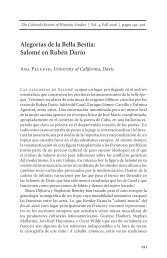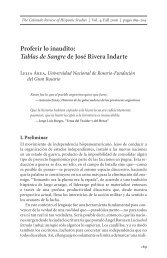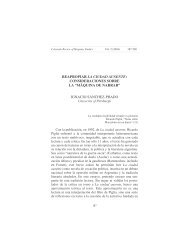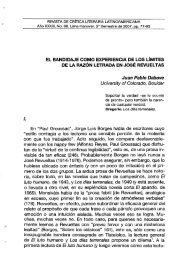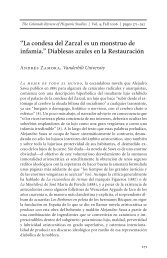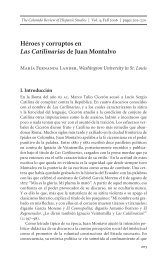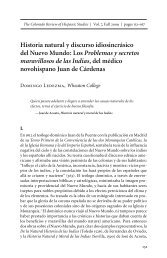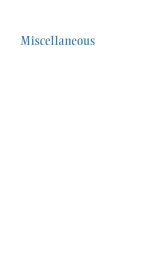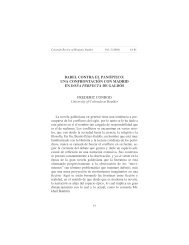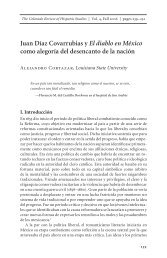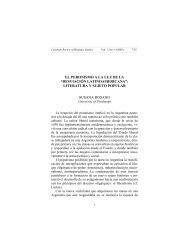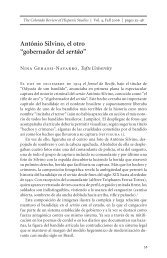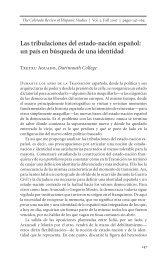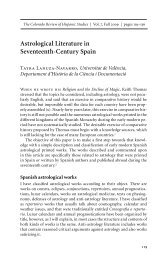Dr. Francisco Hernández and Denmark: The Presence of ... - Spanish
Dr. Francisco Hernández and Denmark: The Presence of ... - Spanish
Dr. Francisco Hernández and Denmark: The Presence of ... - Spanish
You also want an ePaper? Increase the reach of your titles
YUMPU automatically turns print PDFs into web optimized ePapers that Google loves.
<strong>The</strong> Colorado Review <strong>of</strong> Hispanic Studies | Vol. 7, Fall 2009 | pages 169–183<br />
<strong>Dr</strong>. <strong>Francisco</strong> <strong>Hernández</strong> <strong>and</strong> <strong>Denmark</strong>:<br />
<strong>The</strong> <strong>Presence</strong> <strong>of</strong> <strong>The</strong> Mexican Treasury in the<br />
Work <strong>of</strong> Ole Worm. An Introduction.<br />
Rafael Chabrán, Whittier College<br />
“ Thus I wrote on plants… Spain cultivates not one <strong>of</strong> these plants in<br />
her fields, so I was searching for western ones . . . I took into account<br />
the fruits, the leaves, <strong>and</strong> any <strong>of</strong> the names <strong>of</strong> the species as they vary<br />
from region to region, their medicinal powers, the native soil, the<br />
method <strong>of</strong> cultivation, <strong>and</strong> their taste . . .”<br />
—<strong>Francisco</strong> <strong>Hernández</strong>, “Epistle”<br />
Introduction<br />
When visiting the beautiful Botanical Gardens <strong>of</strong> Copenhagen (‘Botanisk<br />
Have’) curious tourists <strong>and</strong> inquisitive visitors will marvel to see plants<br />
from the New World, such as tobacco <strong>and</strong> chocolate growing in full bloom.<br />
If adventurous enough to w<strong>and</strong>er to the Botanisk Centralbibliotek (<strong>The</strong><br />
Central Library <strong>of</strong> <strong>The</strong> Botanical Institute), established in 1752, they might<br />
be fortunate enough to see the magnificent Museum Wormianum—written<br />
by the celebrated Danish scholar, Ole Worm—<strong>and</strong> replete with references<br />
to New World plants. A close reading <strong>of</strong> this text would reveal the<br />
name <strong>of</strong> a <strong>Spanish</strong> physician known for his work on New World botany <strong>and</strong><br />
natural history: <strong>Francisco</strong> <strong>Hernández</strong>.<br />
<strong>Hernández</strong> (c. 1517–1587) was arguably one <strong>of</strong> the most important<br />
European physician-botanists <strong>of</strong> the sixteenth century. 1 With good reason<br />
it can be stated that the utilitarian, pragmatic <strong>and</strong> commercial aspects <strong>of</strong><br />
<strong>Spanish</strong> botany, medicine <strong>and</strong> natural history found their culmination in<br />
the scientific expedition <strong>and</strong> fieldwork <strong>of</strong> <strong>Hernández</strong> undertaken during<br />
the 1570s. Unfortunately, Anglo-American scholarship has not paid sufficient<br />
attention to the development <strong>of</strong> Renaissance <strong>Spanish</strong> botany, medicine<br />
<strong>and</strong> natural history as found in the work <strong>of</strong> <strong>Hernández</strong>. <strong>Hernández</strong> traveled<br />
<strong>and</strong> worked in Spain <strong>and</strong> Mexico (New Spain) but never made his way to<br />
<strong>Denmark</strong>. Despite this, his works were widely known in Northern Europe.<br />
169
170<br />
Rafael Chabrán<br />
<strong>Hernández</strong> identified <strong>and</strong> described more than three thous<strong>and</strong> plants<br />
that were not known in Europe. His work included important descriptions<br />
<strong>of</strong> cacao, chili, corn, tobacco <strong>and</strong> tomato to name but a few. Due to the influence<br />
<strong>of</strong> his work, some European botanists, physicians <strong>and</strong> pharmacists<br />
turned their attention away from Old World medicinal plants toward the<br />
plants <strong>of</strong> the New World as sources for new materia medica. In addition to<br />
being an active physician with clinical experience <strong>and</strong> knowledge gained<br />
through experimentation, he was also an active <strong>and</strong> important botanist.<br />
In 1570 <strong>Hernández</strong> was on the brink <strong>of</strong> a brilliant career. Philip II ordered<br />
him to New Spain where he would lead a scientific expedition, one<br />
<strong>of</strong> the firsts <strong>of</strong> its kind, to study native flora, especially with respect to medicinal<br />
plants <strong>and</strong> their uses. <strong>Hernández</strong>’s “moral <strong>and</strong> natural history” <strong>of</strong><br />
New Spain was more than a work on natural history; he included a series<br />
<strong>of</strong> ethnographic materials on the Valley <strong>of</strong> Mexico. <strong>The</strong> main purpose <strong>of</strong><br />
this expedition was to gather information from native medical practitioners<br />
about “herbs, trees, <strong>and</strong> medicinal plants” with the objective <strong>of</strong> learning<br />
uses, doses, as well as the conditions for cultivation so that medicinal<br />
plants could be grown in Spain.<br />
In 1577 <strong>Hernández</strong> returned to Spain, extremely ill but with high hopes<br />
<strong>of</strong> seeing his work, known as <strong>The</strong> Natural History <strong>of</strong> the Plants <strong>of</strong> New Spain,<br />
published <strong>and</strong> well received. <strong>The</strong> manuscript he turned over to Philip II<br />
was massive: it consisted <strong>of</strong> sixteen folio volumes written in Latin <strong>and</strong><br />
contained descriptions <strong>and</strong> illustrations <strong>of</strong> plants, animals <strong>and</strong> minerals<br />
that were used as materia medica in Mexico. <strong>The</strong> majority <strong>of</strong> the botanical<br />
information found in <strong>Hernández</strong>’s work was not known in Europe at<br />
the time. But instead <strong>of</strong> sending it directly to press, Philip II gave the work<br />
over to Nardo Antonio Recchi, a Neapolitan <strong>and</strong> court physician; Philip<br />
charged Recchi with paring down <strong>Hernández</strong>’s work <strong>and</strong> organizing it so<br />
that the information might be more useful <strong>and</strong> manageable (López Piñero<br />
<strong>and</strong> Pardo, Nuevos 59–71; <strong>Hernández</strong>, De materia medica 58–106).<br />
<strong>The</strong> unfortunate conclusion to this story, however, was that <strong>Hernández</strong>’s<br />
monumental work was never published in his lifetime. Still worse, the<br />
manuscript that Philip II had deposited in the library <strong>of</strong> the Escorial went<br />
up in flames in the terrible fire <strong>of</strong> 1671.<br />
<strong>Dr</strong>. <strong>Francisco</strong> Hern<strong>and</strong>ez <strong>and</strong> <strong>Dr</strong>. Ole Worm:<br />
An Introduction<br />
Since about 1992, we have been working on the life <strong>and</strong> works <strong>of</strong> the<br />
<strong>Spanish</strong> physician, <strong>Dr</strong>. <strong>Francisco</strong> <strong>Hernández</strong>. This work has resulted in<br />
several important publications. 2 Our work in the past has concentrated on<br />
<strong>Hernández</strong> <strong>and</strong> the introduction <strong>of</strong> New World plants into the European<br />
pharmacopoeia, as well as the dissemination <strong>of</strong> his works in Europe. This
<strong>Dr</strong>. <strong>Francisco</strong> <strong>Hernández</strong> <strong>and</strong> <strong>Denmark</strong> 171<br />
research has dealt with the spread <strong>of</strong> <strong>Hernández</strong>’s influence in Spain, Italy,<br />
France, Engl<strong>and</strong> <strong>and</strong> the Netherl<strong>and</strong>s. Recently, while in Copenhagen, we<br />
concentrated on the presence <strong>of</strong> <strong>Francisco</strong> <strong>Hernández</strong>’s work in <strong>Denmark</strong><br />
during the seventeenth century, especially as found in the work <strong>of</strong> the<br />
Danish physician <strong>and</strong> scholar Ole Worm. This work was carried out in the<br />
Botanical Library <strong>of</strong> the Botanical Institute (University <strong>of</strong> Copenhagen)<br />
<strong>and</strong> the Royal Library. 3 Our research focused on a close study <strong>of</strong> Worm’s<br />
most important work Museum Wormianum (1655) <strong>and</strong> his correspondence,<br />
Epistolae, as well as, the works <strong>of</strong> his close associates Thomas Bartholin,<br />
Henrik Fuiren <strong>and</strong> other important Danish botanists <strong>of</strong> his time. <strong>The</strong> present<br />
essay is a summary <strong>of</strong> <strong>and</strong> introduction to that research. We are not<br />
the first to detect the presence <strong>of</strong> <strong>Hernández</strong> in Worm’s work. <strong>The</strong> Danish<br />
scholars, H. D. Schepelern (Worm, Breve) <strong>and</strong> Peter Wagner have both observed<br />
the appearance <strong>of</strong> <strong>Hernández</strong> in Worm’s writing but they have not<br />
situated it within the studies <strong>of</strong> the dissemination <strong>of</strong> the Spaniard’s work in<br />
Northern <strong>and</strong> Southern Europe. 4<br />
In our primary research we have focused on two major figures <strong>of</strong> the<br />
Danish scientific world: Ole Worm (1588–1654) <strong>and</strong> Otto Sperling (1602–<br />
1681). 5 In the present essay we have only focused on the work <strong>of</strong> Worm.<br />
Ole Worm, also known as Olaus Worm, a true polymath, was a physician,<br />
pr<strong>of</strong>essor <strong>of</strong> medicine <strong>and</strong> Rector <strong>of</strong> the University <strong>of</strong> Copenhagen, as well<br />
as the head <strong>of</strong> Copenhagen’s Hortus Medicus (Medical-Botanical Garden).<br />
As Ejnar Hovesen has written: “Already in his lifetime, Ole Worm (1588–<br />
1654) achieved European acclaim, but later his fame was always connected<br />
with his work on prehistory, as runologist <strong>and</strong> as an expert on museums”<br />
(Laegen 304). In addition, he also taught Latin, Greek, anatomy <strong>and</strong> physics<br />
<strong>and</strong> was, as Hovesen has indicated, well known for his scholarship in the<br />
area <strong>of</strong> runology. However, he is perhaps best remembered for his wonderful<br />
Museum Wormianum, a magnificent cabinet <strong>of</strong> curiosities <strong>and</strong> a catalogue<br />
description <strong>of</strong> this museum.<br />
While there is some research on Worm’s Museum, historians <strong>of</strong> science,<br />
especially historians <strong>of</strong> natural history have not placed enough attention on<br />
the impact <strong>of</strong> the work <strong>of</strong> the <strong>Spanish</strong> physician <strong>Dr</strong>. <strong>Francisco</strong> <strong>Hernández</strong> on<br />
the Dane’s life <strong>and</strong> the reception <strong>of</strong> his work <strong>and</strong> thought in <strong>Denmark</strong>. While<br />
the present research is in still a preliminary stage, we can state with a great<br />
deal <strong>of</strong> certainty that Worm was most interested in the work <strong>of</strong> <strong>Hernández</strong>.<br />
This can be clearly seen in the text <strong>of</strong> his works as well as in his correspondence<br />
in which he demonstrates his keen desire to obtain the Accademia de<br />
Lincei’s edition <strong>of</strong> <strong>Hernández</strong> which was not published until 1651, shortly<br />
before Worm’s death in 1654. 6 Nonetheless, we have found numerous references<br />
to <strong>Hernández</strong>’s work in Worm’s writings. Before entering into the<br />
details <strong>of</strong> Worm’s biography <strong>and</strong> intellectual formation we would like to cite<br />
two examples, which underscore Ole Worm’s popularity at the beginning
172<br />
Rafael Chabrán<br />
<strong>of</strong> the twenty-first century. <strong>The</strong> first comes from the work <strong>of</strong> H. P. Lovecraft<br />
(Howard Phillips Lovecraft, 1890–1937) <strong>and</strong> is found in his short stories belong<br />
to the so-called “grimoire” genre, so popular today. In one <strong>of</strong> his stories<br />
a 13th century Dominican priest, based on the figure <strong>of</strong> Worm, translates the<br />
“Necronomicon” from Greek into Latin. <strong>The</strong> second example, a more recent<br />
one, comes from the work <strong>of</strong> Rosamond Purcell, a photographer, artist <strong>and</strong><br />
writer <strong>and</strong> her work on the recreation/re-elaboration <strong>of</strong> Worm’s Museum,<br />
which forms a part <strong>of</strong> her “Two Rooms” exhibit. Purcell’s work is part <strong>of</strong> an<br />
exhibition in which the artist “recreates” or “reconstructs”, a grosso modo,<br />
Worm’s cabinet <strong>of</strong> curiosities. This exhibition has been shown at the Santa<br />
Monica Museum, (San Monica, California), the Museum <strong>of</strong> Art at Mount<br />
Holyoke College <strong>and</strong> at the Harvard Science Center.<br />
Worm’s Early Life <strong>and</strong> Education: <strong>The</strong> Peripatetic Student<br />
Ole Worm was born in Århus in 1588, one year after <strong>Hernández</strong>’s death.<br />
He was the son <strong>of</strong> Wilim Worm, the mayor <strong>of</strong> the City <strong>of</strong> Århus, the principal<br />
port <strong>of</strong> <strong>Denmark</strong>, situated on the northwest <strong>of</strong> the Jutl<strong>and</strong> peninsula<br />
(Hovesen, Laegen 305–7). <strong>The</strong> social <strong>and</strong> economic situation <strong>of</strong> Worm’s<br />
family afforded him many possibilities. Throughout his life he was free to<br />
pursue his academic interests without economic worries.<br />
Worm began his early education in Århus where he studied from 1595<br />
until 1601 (Schepelern 370–2). He then set out to study in Germany, first<br />
to the city <strong>of</strong> Lüneburg, in the region <strong>of</strong> Lüngberger Heide in the north <strong>of</strong><br />
Germany. From there he was sent to Emmerich, where he studied at the<br />
Stifschule for his pre-university preparation.<br />
Worm’s years <strong>of</strong> university study followed a path <strong>of</strong> academic w<strong>and</strong>erings,<br />
which were in many ways a continuation <strong>of</strong> his early education. As<br />
a matter <strong>of</strong> fact, Worm lived most <strong>of</strong> his university career outside <strong>of</strong> his<br />
native <strong>Denmark</strong>. He studied in various European countries <strong>and</strong> dedicated<br />
himself to diverse academic disciplines. Worm began his university studies<br />
at the University <strong>of</strong> Marburg, founded in 1527 <strong>and</strong> as such, one <strong>of</strong> the oldest<br />
Protestant universities <strong>of</strong> Germany (Schepelern 371). At Marburg, Worm<br />
studied philosophy with the noted philosopher Rudolph Goclerious (1547–<br />
1628). Subsequently, the young Worm set <strong>of</strong>f for Giessen to study theology.<br />
During this time Giessen was an important center <strong>of</strong> study for Lutheran<br />
theologians. In 1607 we find Worm in Strasburg, where it seems he began to<br />
study medicine, one <strong>of</strong> his life long pursuits.<br />
From Strasburg he then traveled to Switzerl<strong>and</strong>, to Basel <strong>and</strong> its famous<br />
university. Here he enrolled in the Faculty <strong>of</strong> Medicine. Worm’s studies in<br />
Basel were perhaps the most important <strong>of</strong> his academic career (Schepelern<br />
370). We should recall that Erasmus <strong>and</strong> Paracelsus were prominent elements<br />
in Basel’s academic history. During his time at the Faculty <strong>of</strong>
<strong>Dr</strong>. <strong>Francisco</strong> <strong>Hernández</strong> <strong>and</strong> <strong>Denmark</strong> 173<br />
Medicine, Worm was introduced to the study <strong>of</strong> iatrochemistry <strong>and</strong> learned<br />
first h<strong>and</strong> the ideas <strong>of</strong> Paracelsus. He studied with Pr<strong>of</strong>essor Jacob Zwinger<br />
(1569–1610) who introduced him into the basic concepts <strong>of</strong> iatrochemistry<br />
(Schepelern 371; Shackelford, “To Be or Not to Be a Paracelsian” 54–69).<br />
Through Zwinger he was met the Swiss botanist, Caspar Bauhin (1560–<br />
1624), Johannes Faber (1574–1629), a noted member <strong>of</strong> the Accademia de<br />
Lincei <strong>and</strong> a scholar <strong>of</strong> <strong>Hernández</strong>’s work, as well as Felix Platter (1536–1614),<br />
a Swiss physician <strong>and</strong> collector whose cabinet <strong>of</strong> curiosities was well known. 7<br />
But Worm’s university studies did not end in Basel. In the fall <strong>of</strong> 1608<br />
we find him in Padua with its noted Faculty <strong>of</strong> Medicine <strong>and</strong> famous<br />
Botanical Garden. 8 In Padua he met Caspar Bartholin (1585–1629), an important<br />
Danish scientist <strong>and</strong> theologian, whose family was to be <strong>of</strong> great<br />
importance in Worm’s later life <strong>and</strong> subsequent intellectual development.<br />
He was the father <strong>of</strong> Thomas <strong>and</strong> Rasmus (Erasmus) Bartholin, near family<br />
<strong>and</strong> colleagues <strong>of</strong> Ole Worm. During his stay in Italy, Worm had the<br />
opportunity to travel to Naples where he met the famous natural historian<br />
<strong>and</strong> collector Ferrante Imperato (1550–1615). 9 In 1609 he also traveled to<br />
Bologna where he visited Aldrov<strong>and</strong>i’s well-known collection.<br />
In 1610 Worm began his travels back to his homel<strong>and</strong>. Upon leaving<br />
Italy he traveled through France <strong>and</strong> the Low Countries. He stopped in<br />
Enkhuizen in Northern Holl<strong>and</strong> where he visited the noted Dutch scholar<br />
<strong>and</strong> collector Bernhard Paludanus (1550–1633). Paludanus is remembered<br />
as a famous world traveler <strong>and</strong> a collector <strong>of</strong> objects from Asia <strong>and</strong> the<br />
Americas. 10 However, Worm could restrain neither his desire for travel nor<br />
his academic curiosity. In 1611, we find him traveling in the north <strong>of</strong> Europe.<br />
First we find him in Marburg <strong>and</strong> then in Kessel where he presented himself<br />
to the Court <strong>of</strong> Mortiz, L<strong>and</strong>graf von Hesse (1592–1627) <strong>and</strong> also took<br />
the opportunity to visit the magnificent Kuntskammer (Schepelern 371). In<br />
December <strong>of</strong> 1611, Worm returned to Basel to receive his doctorate <strong>of</strong> medicine.<br />
Subsequently, he journeyed to Holl<strong>and</strong>, Strasburg, <strong>and</strong> Heidelberg,<br />
eventually heading toward Amsterdam. From Amsterdam he traveled to<br />
London where he lived <strong>and</strong> worked for a short while.<br />
After more than a decade <strong>of</strong> travel <strong>and</strong> study, Worm finally returned to<br />
his native <strong>Denmark</strong> in 1613 where he was named pr<strong>of</strong>essor <strong>of</strong> Latin. From<br />
1613 until the time <strong>of</strong> his death in 1654, Worm was to remain in Copenhagen<br />
<strong>and</strong> settle into an academic life <strong>and</strong> <strong>Denmark</strong>’s historic university. In 1615<br />
Worm married Dorothea Finke, the daughter <strong>of</strong> Thomas Finke (1516–1656),<br />
a pr<strong>of</strong>essor <strong>of</strong> medicine at the university (Hovesen, Laegen 309). Through<br />
this marriage, Worm became the brother-in-law <strong>of</strong> his old friend Caspar<br />
Bartholin. Worm had a long <strong>and</strong> distinguished career at the University <strong>of</strong><br />
Copenhagen. He was pr<strong>of</strong>essor <strong>of</strong> Greek <strong>and</strong> Physics <strong>and</strong> in 1624 became<br />
pr<strong>of</strong>essor <strong>of</strong> medicine. He was named Rector <strong>of</strong> the university twice in his<br />
life, first in 1627 <strong>and</strong> then again in 1654, shortly before his death.
174<br />
Worm <strong>and</strong> His Museum<br />
Rafael Chabrán<br />
As we know the history <strong>of</strong> natural history is tied to the history <strong>of</strong> museums<br />
<strong>and</strong> collections <strong>of</strong> curiosities. As Paula Findlen has pointed out these<br />
museums were called studios, theaters, galleries, archives, treasures, p<strong>and</strong>echions,<br />
kunstkammern or wunderkammern (Possessing 48). Worm’s museum<br />
was one <strong>of</strong> these collections, as were those <strong>of</strong> Imperato, Aldrov<strong>and</strong>i,<br />
Della Porta, Calzolari <strong>and</strong> Kircher, although Worm’s was the first museum<br />
in <strong>Denmark</strong> <strong>and</strong> one <strong>of</strong> the first <strong>of</strong> its kind anywhere. 11 Oftentimes these<br />
collections were highly organized <strong>and</strong> catalogued, as with Worm’s.<br />
In spite <strong>of</strong> all his academic endeavors, Ole Worm is best known for his<br />
famous museum <strong>and</strong> its published catalogue, Museum Wormianum (1655).<br />
<strong>The</strong> Museum is a wonderful description <strong>of</strong> his famous cabinet <strong>of</strong> curiosities<br />
<strong>and</strong> provides good examples <strong>of</strong> his vast knowledge <strong>of</strong> natural history <strong>of</strong><br />
both the Old <strong>and</strong> the New Worlds. It contains an exuberant juxtaposition<br />
<strong>of</strong> animal, vegetable, mineral <strong>and</strong> man-made objects.<br />
<strong>The</strong> Museum Wormianum was published in <strong>The</strong> Netherl<strong>and</strong>s, both in<br />
Amsterdam <strong>and</strong> Leiden, perhaps because <strong>of</strong> the author’s close association<br />
with Jan de Laet <strong>and</strong> due to the fact that Worm’s son, Willum Worm<br />
was residing there. In fact, Willum was put in charge <strong>of</strong> the edition, while<br />
Jan de Laet was the actual editor. <strong>The</strong> bulk <strong>of</strong> the text was based on Ole<br />
Worm’s academic lectures, which date from 1646, with some additions<br />
from just before 1655. It is believed that this work was published in the Low<br />
Countries because the editor Jan de Laet had made <strong>and</strong> had in his possession<br />
many <strong>of</strong> the engravings previously for the works <strong>of</strong> Willem Pies or<br />
Piso (c. 1611–1678)—a Dutch physician <strong>of</strong> the Dutch settlement in Brazil<br />
(1636–1644)—<strong>and</strong> the German cartographer, astronomer <strong>and</strong> naturalist<br />
Georg Margrave, or Marcgraf (1610–c. 1644); the works <strong>of</strong> both authors are<br />
important sources for the dissemination <strong>of</strong> Hern<strong>and</strong>ez work. As we will<br />
see, the work <strong>of</strong> Piso <strong>and</strong> Margrave was published in Leiden by Hacke <strong>and</strong><br />
in Amsterdam by Elzever.<br />
It is important to note that Worm’s Museum is important <strong>and</strong> unique.<br />
It is similar to others such as those <strong>of</strong> Ferrante Imperato <strong>and</strong> Francesco<br />
Calzolari, from which Worm incorporated information. Worm also cited<br />
the work <strong>of</strong> other collectors such as Gesner <strong>and</strong> Aldrov<strong>and</strong>i. In addition, he<br />
expressed admiration for the works <strong>of</strong> Clusius, Scaliger <strong>and</strong> Juan Eusebio<br />
Nieremberg, another important <strong>Hernández</strong> scholar.<br />
<strong>The</strong> Contents, Organization <strong>and</strong> History<br />
<strong>of</strong> Worm’s Museum<br />
As one might imagine, the contents <strong>of</strong> the Museum were extremely diverse.<br />
It contained all kinds <strong>of</strong> curiosities, ethnographic rarities, alongside collected<br />
specimens <strong>of</strong> natural history, antiquarian <strong>and</strong> historical objects, <strong>and</strong>
<strong>Dr</strong>. <strong>Francisco</strong> <strong>Hernández</strong> <strong>and</strong> <strong>Denmark</strong> 175<br />
artworks (Schepelern 376–80). In its cases, drawers, walls <strong>and</strong> ro<strong>of</strong> we find<br />
weapons, religious objects, as well as scientific instruments <strong>and</strong> various<br />
specimens <strong>of</strong> taxidermy.<br />
<strong>The</strong> text <strong>of</strong> Worm’s Museum is divided into four books. <strong>The</strong> first deals<br />
with fossils, soils, rocks <strong>and</strong> metals. <strong>The</strong> second book covers plants <strong>and</strong><br />
other botanical specimens. <strong>The</strong> third deals with animals <strong>and</strong> is filled with<br />
citations from Aristotle, Pliny, Gesner <strong>and</strong> Aldrov<strong>and</strong>i. <strong>The</strong> fourth book<br />
describes artificial <strong>and</strong> man-made objects. Worm organized the first three<br />
books <strong>of</strong> his work around the major category <strong>of</strong> “Naturalia,” principally natural<br />
history. <strong>The</strong> fourth book deals with “Artificiosa,” those objects made <strong>of</strong><br />
metal, plant materials (such as wood), <strong>and</strong> animal parts (horns or bones).<br />
Upon his death, Worm’s museum was bought by King Frederick III<br />
(1609–1670) who used it as the foundation for his Royal Kunstkammer.<br />
Unfortunately, today Worm’s museum no longer exists as it did during<br />
his day. During his lifetime it was located on the street known as<br />
Skiderstrade, today Kystalgade, where today we find the Central Public<br />
Library <strong>of</strong> the City <strong>of</strong> Copenhagen (Hovedbibliotek), a few blocks from the<br />
famous Round Tower in Copenhagen’s so-called Latin Quarter. <strong>The</strong> little<br />
that remains <strong>of</strong> Worm’s collection today is to be found in Copenhagen’s<br />
Zoological Museum <strong>and</strong> in the Museum <strong>of</strong> Natural History.<br />
Worm’s Museum <strong>and</strong> its Sources<br />
Serious scholar that he was, Ole Worm left us a treasure trove <strong>of</strong> references<br />
for the research contained in his Museum. 12 A partial list <strong>of</strong> authorities<br />
contains the names <strong>of</strong>: Amatus Lusitanus, Athanasius Kircher,<br />
Bernardus Paludanus, Ferr<strong>and</strong>us Imperatus, Caspar Bauhinus, Franciscus<br />
Hern<strong>and</strong>us, Franciscus Stellatus Lynaeus, Garcias ab Horto, Gulhelmus<br />
Piso, Margravius, Mathiolus, Nardus Antonio Rechus, Nicolaus Monardes,<br />
Petrus Martyr, Scaliger, Thomas Bartholinus, Tycho Brahe <strong>and</strong> Zacutus<br />
Lusitanus—a virtual who’s who <strong>of</strong> Renaissance science <strong>and</strong> natural history.<br />
13 Before entering into Worm’s correspondence, we wish to recall what<br />
Brian W. Ogilvie (2006) has written about the importance that correspondence<br />
had for Renaissance naturalists. In his discussion <strong>of</strong> “<strong>The</strong> Imagined<br />
Community” <strong>and</strong> the network <strong>of</strong> scholars—the Republic <strong>of</strong> Letters— <strong>and</strong><br />
their research, he writes: “But each link in this network, each letter exchanged<br />
between two naturalists, referred implicitly or explicitly to other<br />
links” (Ogilvie 82). A close look <strong>of</strong> Worm’s correspondence will give us a<br />
more complete picture <strong>of</strong> Worm’s interest in <strong>Hernández</strong>. 14 Concentrating<br />
on a selected list <strong>of</strong> these letters, we <strong>of</strong>fer the following chronology, where we<br />
find specific references to <strong>Hernández</strong> <strong>and</strong> his works. In October <strong>of</strong> 1627, we<br />
find one <strong>of</strong> the first references <strong>of</strong> the Accademia dei Lincei in Worm’s correspondence<br />
in a letter from Johannes Andreas/Hans Andersen to Worm
176<br />
Rafael Chabrán<br />
from Padua. 15 In this letter (October 12, 1627) he writes to Worm <strong>and</strong> mentions<br />
important members <strong>of</strong> the Lincei: J. Faber, F. Colonna <strong>and</strong> J. Terentius.<br />
He refers to Faber’s work on Mexican Animals <strong>and</strong> Terentius’s work on<br />
Mexican plants. Ten years later (April 1, 1637), Worm wrote to friend Henrik<br />
Fuiren (1614–1659), <strong>and</strong> mentions the plant Coya Metl <strong>and</strong> Nieremberg’s<br />
Historia natura (1635). 16 That same year we have a letter to Johan Rhode,<br />
which again mentions the Lincei’s edition <strong>of</strong> <strong>Hernández</strong>. 17 Two years later,<br />
on June 28, 1639, in a letter to Thomas Bartholin, he mentions the works <strong>of</strong><br />
Clusius <strong>and</strong> de Laet <strong>and</strong> mentions the Cassia plant. 18 <strong>The</strong>re are several other<br />
letters from 1646 to 1653 from Vito Beringio, de Laet, Petrus Scavenius,<br />
Wilhemus Langius <strong>and</strong> Erasmus/Rasmus Bartholin, which also mention<br />
the work <strong>of</strong> the Lincei.<br />
Ole Worm, the Work <strong>of</strong> <strong>Dr</strong>. <strong>Francisco</strong> <strong>Hernández</strong><br />
<strong>and</strong> <strong>The</strong> Rome Edition<br />
For almost fifty years (1603–1651), the Accademia dei Lincei was involved<br />
in the publication <strong>of</strong> <strong>Francisco</strong> Hern<strong>and</strong>ez’s Mexican Treasury. This work<br />
<strong>of</strong>ten referred to, as “<strong>The</strong> Rome Edition” is one <strong>of</strong> the most important, if<br />
not the most important, editions <strong>of</strong> Hern<strong>and</strong>ez’s work. It is most certainly<br />
the most important in terms <strong>of</strong> the dissemination <strong>of</strong> Hern<strong>and</strong>ez’s writings.<br />
In 1603, Federico Cesi (1585–1630) founded the Accademia dei Lincei,<br />
which was one <strong>of</strong> the first scientific societies <strong>of</strong> the modern period. <strong>The</strong><br />
Accademia dei Lincei was at the same time a scientific society, a scientific<br />
brotherhood <strong>and</strong> a philosophical militia. <strong>The</strong> purpose <strong>of</strong> this society was<br />
to engage in free inquiry into the natural sciences. It sought to investigate<br />
<strong>and</strong> study the many mysteries <strong>of</strong> nature <strong>and</strong> to reorganize knowledge <strong>and</strong><br />
produce a visual theatre <strong>of</strong> nature. In the words <strong>of</strong> its founder, the principle<br />
objective <strong>of</strong> this young men’s intellectual club was to, “read the great <strong>and</strong><br />
true <strong>and</strong> universal book <strong>of</strong> the world.” This scientific society was a secular<br />
counterpart to religious institutions like the Jesuits who also had a firm<br />
commitment to scientific investigation. As with the Jesuits, the Accademia<br />
dei Lincei was a scientific fraternity, which stressed the acquisition <strong>and</strong><br />
mutual exchange <strong>of</strong> knowledge. <strong>The</strong>y also formed an international scientific<br />
network for the transmission <strong>and</strong> reception <strong>of</strong> knowledge.<br />
<strong>The</strong> two principal flagship projects <strong>of</strong> the Academia dei Lincei were<br />
the publication <strong>of</strong> the works <strong>of</strong> Galileo <strong>and</strong> <strong>Francisco</strong> <strong>Hernández</strong>. Galileo<br />
became a member <strong>of</strong> the Accademia dei Lincei in 1611 <strong>and</strong> from that date<br />
the Accademia fostered the publication <strong>of</strong> his works. Francesco Stelutti<br />
was especially influential in publishing <strong>and</strong> collaborating with Galileo.<br />
Galileo, who in turn, was aware <strong>of</strong> the work <strong>of</strong> <strong>Francisco</strong> <strong>Hernández</strong> <strong>and</strong><br />
the Lincei’s publishing <strong>of</strong> the Mexican Treasury.
<strong>Dr</strong>. <strong>Francisco</strong> <strong>Hernández</strong> <strong>and</strong> <strong>Denmark</strong> 177<br />
Members <strong>of</strong> the Accademia dei Lincei came into contact with the work<br />
<strong>of</strong> <strong>Francisco</strong> <strong>Hernández</strong> via two paths: 1) in the context <strong>of</strong> Federico Cesi’s<br />
visit to Naples in 1603, his contact with the noted Neapolitan scholar<br />
Giambattista Della Porta (1538–1615) <strong>and</strong> his attempts to acquire Recchi’s<br />
<strong>Hernández</strong> manuscript (<strong>Hernández</strong>, De materia medica I: 58–70); 2)<br />
within the context <strong>of</strong> members <strong>of</strong> the Accademia dei Lincei’s study <strong>of</strong> the<br />
<strong>Hernández</strong> manuscripts at the Escorial (López Piñero <strong>and</strong> Pardo, Nuevos<br />
133–43). At least three <strong>of</strong> the Lincei visited or attempted to visit the Escorial<br />
Library in order to see <strong>and</strong> study <strong>Hernández</strong>’s texts. <strong>The</strong>se include the visits<br />
<strong>of</strong> Johannes Schreck (c. 1577–1653), also known as “Terrentius,” Eck (Heck<br />
or Herkius), <strong>and</strong> Cassiano dal Pozzo. Cassiano dal Pozzo (1588–1657) was a<br />
seventeenth century patron <strong>of</strong> the arts <strong>and</strong> sciences <strong>and</strong> famous antiquarian.<br />
In 1622 he became a member <strong>of</strong> the Accademia dei Lincei. While in Rome<br />
he came into the service <strong>of</strong> Cardinal Francesco Barberini (1597–1679) <strong>and</strong><br />
nephew to Pope Urban VIII (1623–1646). Cassiano was also instrumental<br />
in commissioning the copy <strong>of</strong> the Codex Cruz Badiano, known today as the<br />
“Erbario Messicano” <strong>and</strong> housed in the Royal Collection in Windsor Castle<br />
(Freedberg 15–38). Cassiano dal Pozzo also visited the Escorial Library,<br />
where he came into contact with the librarian Andrés de los Reyes, the principle<br />
archivist <strong>and</strong> librarian at the Escorial from 1622 to 1638. Cassiano asked<br />
the librarian to copy several important <strong>Hernández</strong> works. Among them,<br />
<strong>Hernández</strong>’s treatise on animals <strong>and</strong> minerals, later published by J. Faber<br />
<strong>and</strong> the most important Index Alphabeticus Plantarum Novae Hispaniae,<br />
which was used for the Rome Edition <strong>and</strong> is <strong>of</strong> great importance in reconstructing<br />
the works <strong>of</strong> <strong>Hernández</strong> burned in the fire <strong>of</strong> 1671.<br />
While Worm was never able to see the Accademia dei Lincei’s edition<br />
<strong>of</strong> <strong>Hernández</strong>’s work, which was published shortly before his death, he<br />
was well aware <strong>of</strong> its existence as can be seen through a close study <strong>of</strong> his<br />
correspondence. In addition, he was in close contact with members <strong>of</strong> the<br />
Accademia dei Lincei, who knew his work, as well as that <strong>of</strong> the <strong>Spanish</strong><br />
physician. Worm also knew <strong>Hernández</strong>’s work from other sources, which<br />
he cited in his works <strong>and</strong> correspondence. Here we are referring to the<br />
writings <strong>of</strong> Juan Eusebio Nieremberg, <strong>Francisco</strong> Ximénez <strong>and</strong> Jan de Laet.<br />
De Laet was perhaps one <strong>of</strong> his most important sources for information<br />
concerning the work <strong>of</strong> <strong>Hernández</strong>. Worm maintained important contacts<br />
<strong>and</strong> correspondence with de Laet, who sent him various specimens<br />
<strong>of</strong> plants, which were <strong>of</strong> interest to the Dane. De Laet, as we will see, was<br />
also very familiar with dried plant specimens from Margrave’s herbarium,<br />
another important source <strong>of</strong> <strong>Hernández</strong>’s work.
178<br />
Ole Worm <strong>and</strong> Jan de Laet<br />
Rafael Chabrán<br />
Even the quickest review <strong>of</strong> Jan de Laet’s life <strong>and</strong> work will help us better<br />
underst<strong>and</strong> the importance that Hern<strong>and</strong>ez had for Worm’s work. While<br />
de Laet was born in Antwerp, early on he settled in Leiden to study in the<br />
city’s noted university. We must not forget Leiden’s close ties to the life<br />
<strong>and</strong> works <strong>of</strong> the well-known botanist, Clusius, another scholar <strong>of</strong> plants<br />
<strong>and</strong> materia medica from the New World (Cook 117–20). In addition to his<br />
studies in Leiden, it also seems that de Laet also studied in London between<br />
1603 <strong>and</strong> 1607, but we do not have much information on this period <strong>of</strong> his<br />
life. De Laet is <strong>of</strong>ten remembered for his geographical work, especially for<br />
his studies <strong>of</strong> France, Spain, Belgium, Turkey, <strong>and</strong> Portugal. However, he<br />
is most well known for the work he accomplished as the Director <strong>of</strong> the<br />
Dutch West Indies Company <strong>and</strong> the geographic, ethnographical <strong>and</strong> botanical<br />
research which de published in conjunction with that position.<br />
In 1625, the de Laet (1582–1691 became interested in <strong>Hernández</strong>. His<br />
work Nieuwe Wereldt <strong>of</strong>te Beschrigvingh van West-Indien (Leiden 1625) <strong>and</strong><br />
Novus Orbis descriptionii Indiae occidentalis (1633) incorporated a great<br />
deal <strong>of</strong> material based on <strong>Hernández</strong>’s writings (López Piñero <strong>and</strong> Pardo,<br />
La influencia 193–195). De Laet’s books described the plants, geography, climate<br />
<strong>and</strong> customs <strong>of</strong> the Caribbean <strong>and</strong> Central <strong>and</strong> South America. <strong>The</strong><br />
primary purpose <strong>of</strong> these works was to serve as a guide for the employees<br />
<strong>of</strong> the Dutch West India Company. As we will see, other men from the Low<br />
Countries who were important for the spread <strong>of</strong> <strong>Hernández</strong>’s work include<br />
Pies <strong>and</strong> Margrave. This work is found in their Historiae rerum naturalium<br />
Brasiliae libri octo, which is part <strong>of</strong> Historiae Naturalis Brasiliae (1648) <strong>and</strong><br />
includes Pies’s De Medicinia Brasilensi libri quattuor. Worm was very interested<br />
<strong>and</strong> well aware <strong>of</strong> all this research as his work <strong>and</strong> correspondence<br />
demonstrates.<br />
Worm <strong>and</strong> <strong>Francisco</strong> Ximénez<br />
Worm’s correspondence with de Laet also introduced him to the aspects<br />
<strong>of</strong> <strong>Hernández</strong>’s writings that came to light thanks to <strong>Francisco</strong> Ximénez.<br />
A significant amount <strong>of</strong> <strong>Hernández</strong>’s work appeared in Ximénez’s Quatro<br />
Libros de la naturaleza y virtudes de las plantas y animals que estan recevidos<br />
en el uso de la Medicina en la Nueva España, published in 1615 (López Piñero<br />
<strong>and</strong> Pardo, La influencia 119–27). Ximénez was a lay hospital brother who<br />
worked with Bernardino Álvarez, a key figure in the history <strong>of</strong> Mexican<br />
hospitals. Ximénez worked at the Hospital <strong>of</strong> the Holy Cross in what is<br />
now the state <strong>of</strong> Morelos where he came into contact with <strong>Hernández</strong>.<br />
Ximénez’s work deals with the Four Books <strong>of</strong> Nature <strong>and</strong> the virtues <strong>of</strong><br />
plants <strong>and</strong> animals that were used as medicines in New Spain <strong>and</strong> the manner<br />
in which they should be prepared <strong>and</strong> administered. María de Espinosa
<strong>Dr</strong>. <strong>Francisco</strong> <strong>Hernández</strong> <strong>and</strong> <strong>Denmark</strong> 179<br />
López Dávalos, widow <strong>of</strong> Diego López Dávalos, printed Ximenez’s work in<br />
Mexico City. <strong>The</strong> primary object <strong>of</strong> Ximenez’s work was to provide practical<br />
medical information, especially the use <strong>of</strong> medicinal plants for people<br />
living in places with no access to physicians or medicines.<br />
Worm, Niermberg <strong>and</strong> <strong>Hernández</strong><br />
As we know, <strong>Hernández</strong>’s work unfortunately remained unpublished in his<br />
native Spain during the seventeenth century, even when it was known in<br />
Mexico, Italy, the Netherl<strong>and</strong>s, Britain <strong>and</strong> France. However, portions <strong>of</strong><br />
<strong>Hernández</strong>’s writings first appeared in Juan Barrios’ Verdadera medicina<br />
cirugía astrología (Mexico 1607), <strong>and</strong> in the writings <strong>of</strong> the seventeenth<br />
century Jesuit theologian <strong>and</strong> pr<strong>of</strong>essor <strong>of</strong> natural history Juan Eusebeo<br />
Nieremberg (c. 1595–1658) Historia naturae, maxime peregrinae (1635).<br />
Nieremberg was another important source for Worm’s knowledge <strong>of</strong><br />
<strong>Hernández</strong> (López Piñero <strong>and</strong> Pardo, Nuevos 129–32).<br />
Worm <strong>and</strong> G. Margrave<br />
As we have seen, the presence <strong>of</strong> New World plants in Worm’s research, especially<br />
through the work <strong>of</strong> <strong>Francisco</strong> <strong>Hernández</strong> is closely tied to the writings<br />
de Laet, Margrave, <strong>and</strong> Pies. 19 <strong>The</strong> connection between <strong>Hernández</strong> <strong>and</strong> <strong>The</strong><br />
Netherl<strong>and</strong>s <strong>and</strong> <strong>Denmark</strong> also originated with the Botanical Garden <strong>of</strong> the<br />
University <strong>of</strong> Leiden (Chabrán <strong>and</strong> Varey, “<strong>Hernández</strong> in the Netherl<strong>and</strong>s<br />
<strong>and</strong> Engl<strong>and</strong>” 138–150). <strong>The</strong> work <strong>of</strong> Margrave <strong>and</strong> Pies was based on their<br />
research carried out for the Dutch West Indies Company’s colony in Brazil.<br />
<strong>The</strong> primary purpose <strong>of</strong> this enterprise was to contain the political <strong>and</strong><br />
economic dominance <strong>of</strong> Spain <strong>and</strong> Portugal in the New World. 20 Here we<br />
should recall that the Dutch had begun to revolt against the <strong>Spanish</strong> in 1568.<br />
Subsequently, the directors <strong>of</strong> the Dutch Indies Company appointed Count<br />
Johan Maurits <strong>of</strong> Nassau-Siegen (1604–1678) not only to set up a colony<br />
in Brazil, but also to sponsor some <strong>of</strong> the first European scientific studies<br />
<strong>of</strong> Brazil. 21 Dutch artists <strong>and</strong> scientists such as Albert Eckhout (c. 1607– c.<br />
1644), Franz Post (1612–1680), Margrave <strong>and</strong> Piso created some <strong>of</strong> the first<br />
European descriptions <strong>of</strong> Brazil’s flora <strong>and</strong> fauna. 22 Count Johan Maurits<br />
<strong>of</strong> Nassau-Siegen’s sponsorship <strong>of</strong> Margrave <strong>and</strong> Piso’s research in Brazil<br />
would result in the publication <strong>of</strong> Historia naturalis Brasiliae (1648), the first<br />
important natural history <strong>of</strong> Brazil. 23 Margrave’s work on Brazilian natural<br />
history was posthumously decoded <strong>and</strong> edited by Jan de Laet in 1648. 24<br />
Margrave had studied, described, drawn <strong>and</strong> dried many native plants from<br />
Brazil. <strong>The</strong> descriptions <strong>and</strong> their illustrations, as well as a great herbarium<br />
were brought back from Brazil by Johan Maurits, who in turn entrusted<br />
these items to be organized <strong>and</strong> edited by de Laet for publication. This made
180<br />
Rafael Chabrán<br />
much sense since de Laet <strong>and</strong> Margrave had corresponded a great deal as<br />
well having shared information on New World plants <strong>and</strong> animals.<br />
<strong>The</strong> work <strong>of</strong> Margrave soon came to the attention <strong>of</strong> Ole Worm though<br />
the h<strong>and</strong>s <strong>of</strong> de Laet. De Laet not only corresponded with Worm but also<br />
sent him specimens <strong>of</strong> minerals, woods <strong>and</strong> fruits. On April 21, 1648, Worm<br />
received a copy <strong>of</strong> Pies <strong>and</strong> Margrave’s Historia naturalis Brasiliae. 25 Shortly<br />
before his death in 1649, de Laet wrote to Cassiano dal Pozzo asking him<br />
about the publication <strong>of</strong> the Lincei’s edition <strong>of</strong> <strong>Hernández</strong>’s work. 26 As we<br />
know, it was not published until 1651. In 1649, Worm also received notice <strong>of</strong><br />
de Laet’s death from Rasmus Bartholin (1625–1698), a Danish scientist <strong>and</strong><br />
physician <strong>and</strong> young brother <strong>of</strong> Thomas Bartholin, who at the time was<br />
living in Leiden. 27<br />
In 1653, Worm’s son, Willum Worm (1633–1704) was studying in Leiden<br />
<strong>and</strong> working on the publication <strong>of</strong> his father’s Museum Wormianum when<br />
he acquired Margrave’s herbarium (Schepelern 376–7). Subsequently this<br />
herbarium was sent to the elder Worm who studied <strong>and</strong> worked with it until<br />
his death in August 1654. As Peter Wagner has pointed out, Margrave’s<br />
work, at this point was well known to Worm. 28 We should recall the<br />
Margrave’s work was full <strong>of</strong> references to <strong>Hernández</strong>. Again we will remember<br />
that in the last years <strong>of</strong> his life Worm complained to his friends <strong>and</strong><br />
correspondents that while he knew <strong>of</strong> the Accademia dei Lincei’s edition <strong>of</strong><br />
Hern<strong>and</strong>ez’s work, he had not seen it.<br />
Conclusion<br />
While there is clearly much more work to be done with respect to the presence<br />
<strong>of</strong> the work <strong>and</strong> thought <strong>of</strong> <strong>Francisco</strong> <strong>Hernández</strong> in <strong>Denmark</strong>, a close<br />
study <strong>of</strong> his Museum <strong>and</strong> correspondence reveals that the Dane was most<br />
interested in New World botany <strong>and</strong> natural history, especially as found<br />
in the works <strong>of</strong> <strong>Hernández</strong>. It is also clear that much <strong>of</strong> what Worm knew<br />
about <strong>Hernández</strong> came from his Dutch friend <strong>and</strong> colleague, Jan de Laet.<br />
As can be seen from a careful study <strong>of</strong> Worm’s correspondence, Worm<br />
learned a great deal about Hern<strong>and</strong>ez from his correspondence with de<br />
Laet. In these letters we find many references to the works <strong>of</strong> <strong>Francisco</strong><br />
Ximénez, as well as to the writings <strong>of</strong> the Jesuit Juan Eusebio Nieremberg,<br />
both <strong>of</strong> whom were important sources for the study <strong>of</strong> <strong>Hernández</strong>. In addition,<br />
again through his contacts with de Laet, Worm was able to find<br />
important references to Hern<strong>and</strong>ez in the works <strong>of</strong> Margrave <strong>and</strong> Pies.<br />
Perhaps most useful was his access to Margrave’s herbarium.<br />
As we have indicated, much more research needs to be undertaken on<br />
the interesting connections between scholars who devoted their lives to<br />
the study <strong>of</strong> New World plants in <strong>Denmark</strong>. Along these lines, future research<br />
into the work <strong>of</strong> the Danish scientist <strong>and</strong> physician, Otto Sperling
<strong>Dr</strong>. <strong>Francisco</strong> <strong>Hernández</strong> <strong>and</strong> <strong>Denmark</strong> 181<br />
will help complete our knowledge <strong>of</strong> <strong>Hernández</strong>’s presence in <strong>Denmark</strong>.<br />
Furthermore, the New World plants found in Worm’s work need to be<br />
studied <strong>and</strong> compared with those found in <strong>Hernández</strong>’s work <strong>and</strong> other<br />
works which contain botanical information from <strong>Hernández</strong>. In the end,<br />
we will have a more complete picture <strong>of</strong> the dissemination <strong>of</strong> <strong>Hernández</strong>’s<br />
work both in northern <strong>and</strong> southern Europe.<br />
Endnotes<br />
1 For a brief introduction to the life <strong>and</strong> works <strong>of</strong> <strong>Dr</strong>. <strong>Francisco</strong> <strong>Hernández</strong>, see Chabrán,<br />
“<strong>Francisco</strong> <strong>Hernández</strong>.”<br />
2 See Chabrán <strong>and</strong> Varey, “Mexican Medicine Comes to Engl<strong>and</strong>,” Varey <strong>and</strong> Chabrán, “Medical<br />
Natural History in the Renaissance” Varey, Chabrán, <strong>and</strong> Weiner, Searching for the Secrets <strong>of</strong><br />
Nature; <strong>and</strong> <strong>Hernández</strong>, <strong>The</strong> Mexican Treasury.<br />
3 While working at the Botanical Library <strong>of</strong> the Botanical Institute (University <strong>of</strong> Copenhagen), I<br />
collaborated <strong>and</strong> received a great deal <strong>of</strong> help <strong>and</strong> attention from two Danish scientists <strong>Dr</strong>. Hans<br />
Tybjerg <strong>and</strong> <strong>Dr</strong>. Peter Wagner. Both <strong>of</strong> these scholars provided me with much bio-bibliographical<br />
help, as well as a better underst<strong>and</strong>ing <strong>of</strong> the history <strong>of</strong> Danish botany during the time <strong>of</strong> Ole<br />
Worm.<br />
4 We are deeply indebted Schepelern’s work, both his study <strong>of</strong> Worm’s life <strong>and</strong> work (Museum<br />
Wormianium), as well as his edition <strong>of</strong> Worm’s correspondence. Our research would have been<br />
impossible without these works.<br />
5 On Sperling see Gigas.<br />
6 We discuss the Accademia de Lincei below.<br />
7 Platter was also a follower <strong>of</strong> the Swiss naturalist Conrad Gesner (1516–1565). On Bauhin <strong>and</strong><br />
Platter, see Ogilve.<br />
8 On the importance <strong>of</strong> <strong>The</strong> Botanical Garden <strong>of</strong> Padua, see Minelli.<br />
9 Schepelern (1971): p. 371.<br />
10 On Paludanus <strong>and</strong> his collection, see B. Ogilvie (2008): pp. 40-41.<br />
11 This type <strong>of</strong> museum also existed in Spain, as evidenced by Vincencio Juan de Lastanosa’s cabinet<br />
<strong>of</strong> curiosities. On Lastanosa see Rey Bueno <strong>and</strong> López Pérez.<br />
12 See the section “Authores Museum Wormianum seu Historis Rariornum” <strong>of</strong> Worm’s work.<br />
13 In keeping with Worm’s text, we have cited the Latinized versions <strong>of</strong> all names.<br />
14 In our study <strong>of</strong> Worm’s correspondence we have used <strong>and</strong> studied both the published Latin version,<br />
the Epistolae, as well as Schepelern’s edition: Breve fra og til Ole Worm, which is an annotated<br />
Danish translation <strong>of</strong> the Worm letters. <strong>The</strong> original copies <strong>of</strong> Worm’s correspondence are<br />
housed at Copenhagen’s Royal Library.<br />
15 Johannes Andreas (Hans Andersen) to Worm dated Oct 12, 1627 (Epistolae 146, p. 125; Breve,<br />
Nº 233, I:134–138).<br />
16 Worm’s letter to Henrik Fuiren (Epistolae I, 188; Breve Nº 633, 4-5). <strong>The</strong> Danish naturalist <strong>and</strong><br />
physician H. Fuiren (1614–1659) was Worm’s nephew <strong>and</strong> student. Like many Danes he studied<br />
at several European universities such as Leiden, Paris, Pisa <strong>and</strong> Padua. Like Worm he took his<br />
medical degree at the University <strong>of</strong> Basel. Schepelern has pointed out Furien’s knowledge <strong>of</strong><br />
Nieremberg: “Bl<strong>and</strong>t samtidige Forskere citers 12 Gange Jesuiten Johann Eugenius Nierenberg<br />
(1590–1658), født i Madrid af tyske Foraeldre. Hans Historia naturae maxime peregrina. Antwerpen<br />
1635, Fol., der ver illustreret med Traesnit, som angives at vaere lidet vaedifulde, erhvervede<br />
Worm aabenbart kort efter dets Udgivelse, idet han hensviser til det allerede i et Brev fra 1637 til<br />
Henrik Fuiren i Leyden og flere Gange senere” (Museum 225).<br />
17 1637 letter from Worm to Johan Rhode (Epistolae 79 [2./10.3. 1637]; Breve II: 3–4). <strong>The</strong> Danish<br />
physician Johannes or Johan Rhode (1587–1659) close friend <strong>of</strong> Caspar Bartholin settled in Padua<br />
<strong>and</strong> practiced medicine <strong>and</strong> botany there.
182<br />
Rafael Chabrán<br />
18 Worm to Thomas Bartholin (Epistolae 653; Breve Nº793 II:135–137). <strong>The</strong> Danish physician <strong>and</strong><br />
anatomist Thomas Bartholin or Bartholinus (1616–1680) was an extremely important figure in<br />
Danish science <strong>and</strong> medicine. He was the son <strong>of</strong> Worm’s brother in law Caspar Bartholin. Upon<br />
the death <strong>of</strong> the latter, he was adopted by Worm. On Thomas Bartholin, see Skavlen.<br />
19 See the important research on Margrave’ herbarium in Andrade-Lima, <strong>and</strong> Wagner (“Das<br />
Markgraf Herbarium”).<br />
20 On the Dutch in Brazil, see Ferrão <strong>and</strong> Montero Soares, <strong>and</strong> Boxer.<br />
21 See Whitehead <strong>and</strong> Boesman, <strong>and</strong> van den Boogaart.<br />
22 R. P. Brienen. Visions <strong>of</strong> Savage Paradise. Albert Eckhout, Court Painter in Colonial Brazil. Amsterdam:<br />
Amsterdam University Press, 2006: p. 12–13. See also her valuable article, R. P. Brienen. “Georg<br />
Marcgraf (1610–c. 1644). A German Cartographer. Astronomer, <strong>and</strong> Naturalist-Illustrator in<br />
Colonial Dutch Brazil.” Itinerario XXXV (2000/1): pp. 85–112. Eckhout’s paintings can still be seen<br />
today in Copenhagen’s Nationalmuseet.<br />
23 R. P. Brienen (2006): p. 16.<br />
24 Chabrán <strong>and</strong> Varey (2000): p. 139. See also the important work <strong>of</strong> J. M. López Piñero <strong>and</strong> J. Pardo,<br />
“Georg Marggraf, Jan de Laet y la Compañia hol<strong>and</strong>esa de las Indias Occidentales” in J. M. López<br />
Piñero <strong>and</strong> José Pardo Tomás. La influencia de <strong>Francisco</strong> <strong>Hernández</strong> (1515–1587) en la constitución de<br />
la botánica y la materia médica modernas. Valencia: University <strong>of</strong> Valencia, 1996: pp. 190–195.<br />
25 Letter from Ole Worm to J. de Laet (April 21, 1648). See, Breve Fra og Til O. Worm. Schepelern.<br />
Vol. 3: pp. 312-313.<br />
26 See J. M. López Piñero <strong>and</strong> J. Pardo (1996): p. 193.<br />
27 Letter from R. Bartholin to Ole Worm (December 27, 1649). See, Breve Fra og Til O. Worm.<br />
Schepelern. Vol. 3: pp. 413–415.<br />
28 Peter Wagner. “Das Markgraf Herbarium” in Sein Feld war die Welt:Johann Moritz von Nassau-Siegen<br />
(1604–1679) edited by Gerhard Brunn <strong>and</strong> Cornelius Neutsch. Waxmann/J. Mortiz, 2008: pp.<br />
233–245; P. Wagner. “<strong>The</strong> Markgraf Herbarium.” Unpublished typed manuscript.<br />
Works Cited<br />
Andrade-Lima, D. et al. “Margrave’s Brazilian Herbarium. Collected 1638–1644.” Saert. Bot. Tidsskrift<br />
71 (1977): 121-60.<br />
Boxer, C. R. <strong>The</strong> Dutch in Brazil: 1624–1654. Oxford: Claredon Press, 1957.<br />
Chabrán, Rafael. “<strong>Francisco</strong> <strong>Hernández</strong>.” Dictionary <strong>of</strong> Medical Biography. Ed. W.F Bynum <strong>and</strong> H.<br />
Bynum. Westport, Conn.: Greenwood Press, 2007. III: 632–637.<br />
Chabrán, Rafael <strong>and</strong> Simon Varey, “An Epistle to Arias Montano: An English Translation <strong>of</strong> a Poem by<br />
<strong>Francisco</strong> <strong>Hernández</strong>.” <strong>The</strong> Huntington Library Quarterly. Vol. 55 No. 2, (1995) : pp. 621–634.<br />
Chabrán, Rafael <strong>and</strong> Simon Varey. “<strong>Hernández</strong> in the Netherl<strong>and</strong>s <strong>and</strong> Engl<strong>and</strong>.” Searching for the<br />
Secrets <strong>of</strong> Nature: <strong>The</strong> Life <strong>and</strong> Works <strong>of</strong> <strong>Dr</strong>. <strong>Francisco</strong> <strong>Hernández</strong>. Ed Simon Varey. Stanford,<br />
California: Stanford University Press, 2000. 138–150.<br />
Chabrán, Rafael <strong>and</strong> Simon Varey. “Mexican Medicine Comes to Engl<strong>and</strong>.” Viator: Medieval <strong>and</strong><br />
Renaissance Studies (University <strong>of</strong> California, Los Angeles). Vol. 26. (1995): pp. 333–353.<br />
Cook, Harold J. Matters <strong>of</strong> Exchange: Commerce, Medicine, <strong>and</strong> Science in the Dutch Golden Age. New<br />
Haven: Yale University Press, 2007<br />
De Laet, J. Nieuwe Wereldt <strong>of</strong>te Beschrigvingh van West-Indien. Leiden, 1625.<br />
De Laet, J. Novus Orbis descriptionii Indiae occidentalis. 1633.<br />
Ferrão, Cristina <strong>and</strong> José Paulo Montero Soares (eds.). Dutch Brazil. 3 vols. Rio de Janeiro: Editoria<br />
Index, 1997.<br />
Findlen, Paula. Possessing Nature. Berkeley: University <strong>of</strong> California Press, 1994.<br />
Freedberg. David. <strong>The</strong> Eye <strong>of</strong> the Lynx: Galileo, His Friends, <strong>and</strong> the Beginnings <strong>of</strong> Modern Natural History.<br />
Chicago: University <strong>of</strong> Chicago Press, 2003.<br />
Gigas, E. “Notes du voyage en Espagne (1640–410 du mèdecine Otto Sperling.” Revue Hispanique 23<br />
(1910): 534–590.
<strong>Dr</strong>. <strong>Francisco</strong> <strong>Hernández</strong> <strong>and</strong> <strong>Denmark</strong> 183<br />
<strong>Hernández</strong>, <strong>Francisco</strong>. Rerum medicarum Hispaniae <strong>The</strong>saurus . . . Rome, 1651.<br />
___. “An Epistle to Arias Montano: An English Translation <strong>of</strong> a Poem by <strong>Francisco</strong> <strong>Hernández</strong>.” Trans.<br />
<strong>and</strong> ed. Rafael Chabrán <strong>and</strong> Simon Varey. <strong>The</strong> Huntington Library Quarterly. Vol. 55 No. 2, (1995)<br />
: pp. 621–634.<br />
___. De materia medica novae Hispaniae libri quatuor. Cuatros libros sobre la materia médica de Nueva<br />
España. Ed. Álvarez Peláez, R. <strong>and</strong> F. Fernández González. 2 vols. Madrid: Ediciones Doce<br />
Calles, 1998.<br />
___. <strong>The</strong> Mexican Treasury: <strong>The</strong> Writings <strong>of</strong> <strong>Dr</strong>. <strong>Francisco</strong> <strong>Hernández</strong>. Ed. Simon Varey. Trans. Rafael<br />
Chabrán <strong>and</strong> Cynthia Chamberlin. Stanford, California: Stanford University Press, 2000: pp.<br />
33–40.<br />
Hovesen, E. Laegen Ole Worm. Århus: Århus Universitetsforlag, 1987.<br />
López Piñero, J. M. <strong>and</strong> José Pardo Tomás. Nuevos materiales y noticias sobre la Historia de las Plantas de<br />
Nueva España de <strong>Francisco</strong> <strong>Hernández</strong>. Valencia University <strong>of</strong> Valencia,1994.<br />
___. La influencia de <strong>Francisco</strong> <strong>Hernández</strong> (1515–1587) en la constitución de la botánica y la materia<br />
médica modernas. Valencia: University <strong>of</strong> Valencia, 1996.<br />
Minelli, A. <strong>The</strong> Botanical Garden <strong>of</strong> Padua: 1545–1995. Trans. G. Barker. New York: Marsillo Publishing,<br />
1996.<br />
Nieremberg, J. E. Historia naturae, maxime peregrinae. 1635.<br />
Ogilvie, Brian W. <strong>The</strong> Science <strong>of</strong> Describing: Natural History in Renaissance Europe. Chicago: University<br />
<strong>of</strong> Chicago Press, 2006.<br />
Purcell, R. “Bring Nature Inside: 17th Century Natural History, Classification, <strong>and</strong> Vision.” Special<br />
Exhibition Gallery. Science Center. Cambridge, 2004-2005.<br />
Rey Bueno, Mar <strong>and</strong> Miguel López Pérez (eds.) <strong>The</strong> Gentleman, the Virtuoso, the Inquirer: Vincencio Juan<br />
de Lastanosa <strong>and</strong> the Art <strong>of</strong> Collecting in Early Modern Spain. London: Cambridge Scholars, 2008.<br />
Schepelern, H. D. Museum Wormianium. Diss. University <strong>of</strong> Copenhagen , 1971. Copenhagen:<br />
Wormiaium, 1971.<br />
Shackelford, J. “To Be or Not to Be a Paracelsian: Something Spagyric in the State <strong>of</strong> <strong>Denmark</strong>.”<br />
Paracelsian Moments: Science, Medicine, & Astrology in Early Modern Europe. Ed. Gerhild Scholz<br />
Williams. Kirksville, Missouri: Trumen State University, 2003: pp. 35–69.<br />
Skavlen, J.K.. “<strong>The</strong> Scientific Life <strong>of</strong> Thomas Bartholin.” Annales <strong>of</strong> Medical History 3 (1921): 67–81.<br />
Van den Boogaart, E. (ed.). Johan Maurits <strong>of</strong> Nassau-Siegen: A Humanist Prince in Brazil <strong>and</strong> Europe. <strong>The</strong><br />
Hague: Johan Maurits Stiching, 1979.<br />
Varey, Simon <strong>and</strong> Rafael Chabrán. “Medical Natural History in the Renaissance: <strong>The</strong> Strange Case <strong>of</strong><br />
<strong>Francisco</strong> <strong>Hernández</strong>.” <strong>The</strong> Huntington Library Quarterly. Vol. 47 No. 2 (1994): 125–151.<br />
Wagner, Peter. “Das Markgraf Herbarium.” Sein Feld war die Welt: Johann Moritz von Nassau-Siegen<br />
(1604–1679) Ed. Gerhard Brunn <strong>and</strong> Cornelius Neutsch. Waxmann/J. Mortiz, 2008. 233–245.<br />
___. “Das Markgraf Herbarium.” Sein Feld war die Welt: Johann Moritz von Nassau-Siegen (1604–1679).<br />
Ed Gerhard Brunn <strong>and</strong> Cornelius Neutsch. Münster: Waxmann/J. Mortiz, 2008. 233-245.<br />
Whitehead, P. J. <strong>and</strong> M. Boesman. A Portrait <strong>of</strong> Dutch Seventeenth Century Brazil. Animals, Plants, <strong>and</strong><br />
People by Artists <strong>of</strong> Johan Maurits <strong>of</strong> Nassau. Amsterdam: North Holl<strong>and</strong> Publishing Company,<br />
1988<br />
Worm, Ole. Epistolae: medici, anatomici, botanici, physici & historici argumenti: rem vero literariam,<br />
linguasque & antiquitates boreales potissimum illustrantes. 2 vols. Havniae, 1751.<br />
___. Museum Wormianum: seu historia rerum rariorum, tam naturalium, quam artificialium, tam domesticarum,<br />
quam exoticarum, quæ Hafniæ Danorum in œdibus authoris fervantur Apud I. Elsevirium,<br />
1655.<br />
___. Breve fra og til Ole Worm. Ed. H. D. Schepelern. 3 vols. Copenhagen, Menksgaard, 1965–1968.<br />
Ximénez. F. Quatro Libros de la naturaleza. Mexio, 1615.



